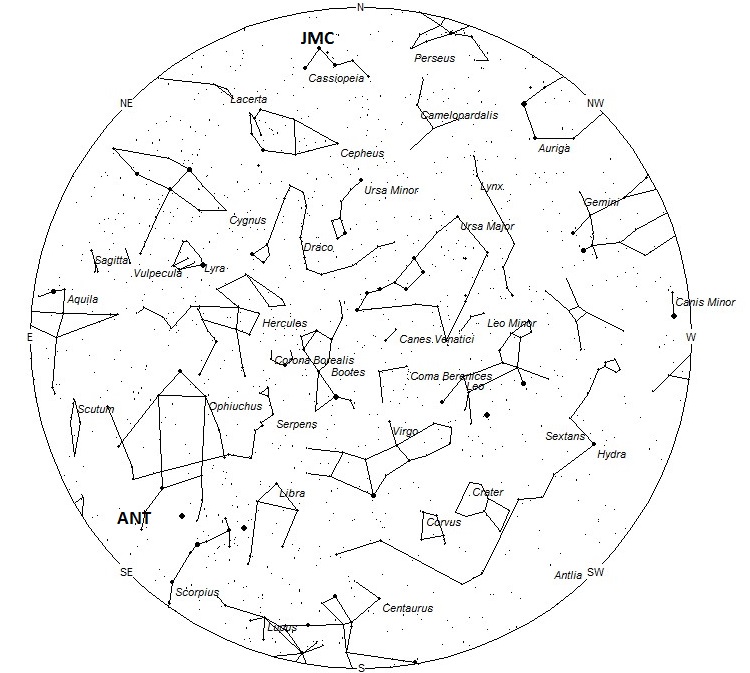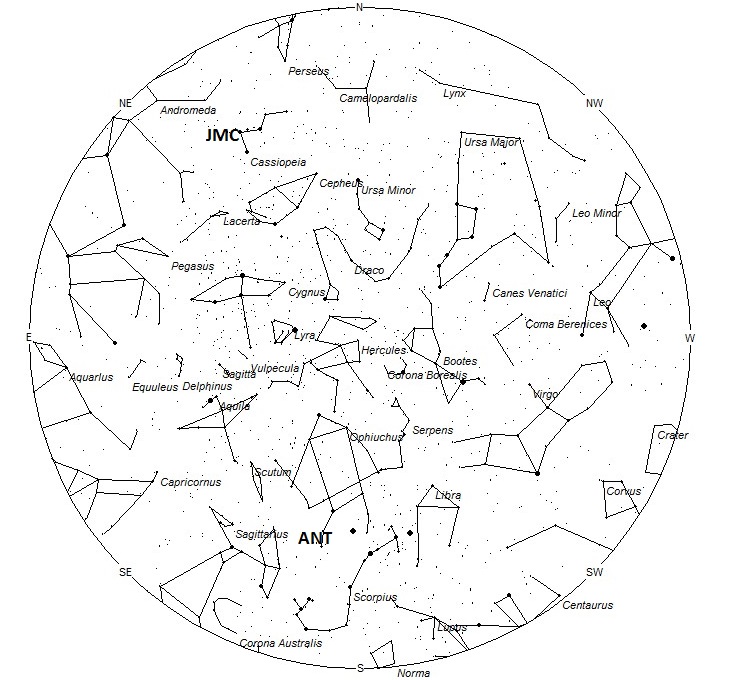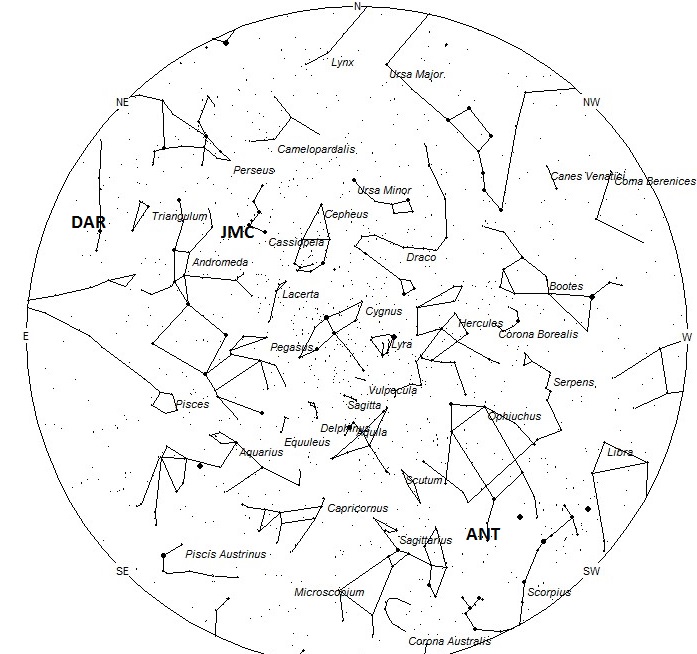
During this period the moon reaches its last quarter phase on Sunday May 29th. At this time the half-illuminated moon will rise shortly after near 0100 local daylight saving time (LDST) and will remain above the horizon the remainder of the night. While the half-illuminated moon is bright, successful meteor observations can be obtained by simply keeping the moon out of your field of view. Conditions improve with each passing night as the moon wanes and rises later morning. The estimated total hourly meteor rates for evening observers this week is near 3 for observers located in the northern hemisphere and 4 for observers located south of the equator. For morning observers the estimated total hourly rates should be near 6 as seen from mid-northern latitudes (45N) and 11 as seen from tropical southern locations (25S). The actual rates will also depend on factors such as personal light and motion perception, local weather conditions, alertness and experience in watching meteor activity. Morning rates are reduced during this period due to moonlight. Note that the hourly rates listed below are estimates as viewed from dark sky sites away from urban light sources. Observers viewing from urban areas will see less activity as only the brightest meteors will be visible from such locations.
The radiant (the area of the sky where meteors appear to shoot from) positions and rates listed below are exact for Saturday night/Sunday morning May 28/29. These positions do not change greatly day to day so the listed coordinates may be used during this entire period. Most star atlases (available at science stores and planetariums) will provide maps with grid lines of the celestial coordinates so that you may find out exactly where these positions are located in the sky. A planisphere or computer planetarium program is also useful in showing the sky at any time of night on any date of the year. Activity from each radiant is best seen when it is positioned highest in the sky, either due north or south along the meridian, depending on your latitude. It must be remembered that meteor activity is rarely seen at the radiant position. Rather they shoot outwards from the radiant so it is best to center your field of view so that the radiant lies at the edge and not the center. Viewing there will allow you to easily trace the path of each meteor back to the radiant (if it is a shower member) or in another direction if it is a sporadic. Meteor activity is not seen from radiants that are located far below the horizon. The positions below are listed in a west to east manner in order of right ascension (celestial longitude). The positions listed first are located further west therefore are accessible earlier in the night while those listed further down the list rise later in the night.
These sources of meteoric activity are expected to be active this week.
The center of the large Anthelion (ANT) radiant is currently located at 17:24 (261) -23. This position lies in southeastern Ophiuchus, 2 degrees northeast of the 3rd magnitude star known as theta Ophiuchi. Due to the large size of this radiant, Anthelion activity may also appear from the nearby constellations of western Sagittarius, Serpens Caput, and northern Scorpius as well as Ophiuchus. This radiant is best placed near 0200 local daylight saving (LDST), when it lies on the meridian and is located highest in the sky. Hourly rates at this time should be near 1 as seen from mid-northern latitudes and 2 as seen from tropical southern latitudes. With an entry velocity of 30 km/sec., the average Anthelion meteor would be of slow velocity.
The June Mu Cassiopeiids (JMC) were discovered by Dr, Peter Brown and associates using data from the Canadian Meteor Orbit Radar (CMOR) installation. These meteors are active from May 31-June 5, with maximum activity occurring on June 1st. The radiant position at maximum lies at 00:44 (011) +53. This area of the sky lies in southern Cassiopeia, close to the area occupied by the 4th magnitude star known as zeta Cassiopeiae. These meteors are best seen near during the last dark hour of the night when the radiant lies highest in a dark sky. These meteors are better seen from the northern hemisphere where the radiant rises higher into the sky before the start of morning twilight. Hourly rates, even at maximum are expected to remain less than 1. With an entry velocity of 42 kilometers per second, a majority of these meteors will appear to move with medium velocities.
The radiant for the Daytime Arietids (ARI) only lies 45 degrees west of the sun. Therefore these meteors can only be seen between the time the radiant rises and dawn. This is a small window of opportunity that lasts for about an hour before the break of dawn. The current position of the radiant is 02:20 (035) +23. This position lies in western Aries, 2 degrees southeast of the 2nd magnitude star known as Hamal (Alpha Arietis). Despite being a strong source of meteors, visual members of this shower are rare due to the low altitude of the radiant. If this radiant was better placed in the sky it would rival the better known Perseids of August. These meteors are the strongest source of radio meteors for the entire year. With an entry velocity of 42 km/sec., the average Daytime Arietid meteor would be of medium speed.
As seen from the mid-northern hemisphere (45N) one would expect to see approximately 5 sporadic meteors per hour during the last hour before dawn as seen from rural observing sites. Evening rates would be near 2 per hour. As seen from the tropical southern latitudes (25S), morning rates would be near 9 per hour as seen from rural observing sites and 3 per hour during the evening hours. Locations between these two extremes would see activity between the listed figures. Morning rates are reduced due to moonlight during this period.
The list below offers the information from above in tabular form. Rates and positions are exact for Saturday night/Sunday morning except where noted in the shower descriptions.
| SHOWER | DATE OF MAXIMUM ACTIVITY | CELESTIAL POSITION | ENTRY VELOCITY | CULMINATION | HOURLY RATE | CLASS |
|---|---|---|---|---|---|---|
| RA (RA in Deg.) DEC | Km/Sec | Local Daylight Saving Time | North-South | |||
| Anthelions (ANT) | – | 17:24 (261) -23 | 30 | 02:00 | 1 – 2 | II |
| June Mu Cassiopeiids (JMC) | Jun 01 | 00:44 (011) +53 | 42 | 09:00 | <1 – <1 | IV |
| Daytime Arietids (ARI) | Jun 07 | 02:20 (035) +23 | 42 | 11:00 | <1 – <1 | IV |
 American Meteor Society
American Meteor Society



Hi There,
I don’t know if I heard the sound of a meteor or what. It was at about 3:40 or 3:45 a.m. CDT on the morning of June 1 and woke me up. I thought our oil burner furnace turned on (but it wasn’t on) and was much louder than our furnace ever was (lower rumble) for what seemed to be about 8-10 seconds, then it got a lot louder (same frequency but much louder) for about 3-5 seconds, then stopped completely, but there was one bright flash of light then a dimmer one within a second of each other or less just after the loud sound stopped. I went outside to see if it was a thunder storm but the sky was all dark and just stars, planets – no clouds, no large machinery, etc. I couldn’t see any jets or planes either. My husband woke up towards the end of the loud noise part, and dismissed it as some type of military testing. We live about 7 mi north of the 45 parallel.